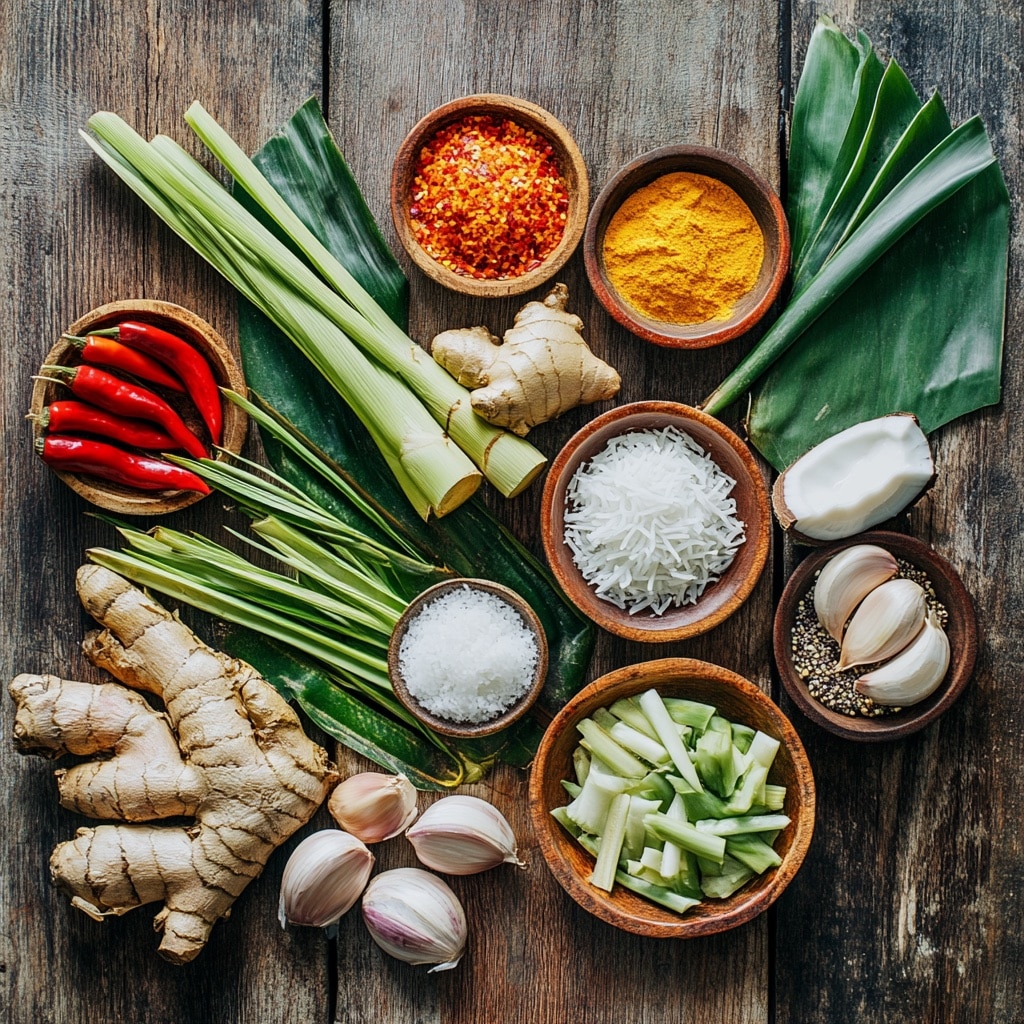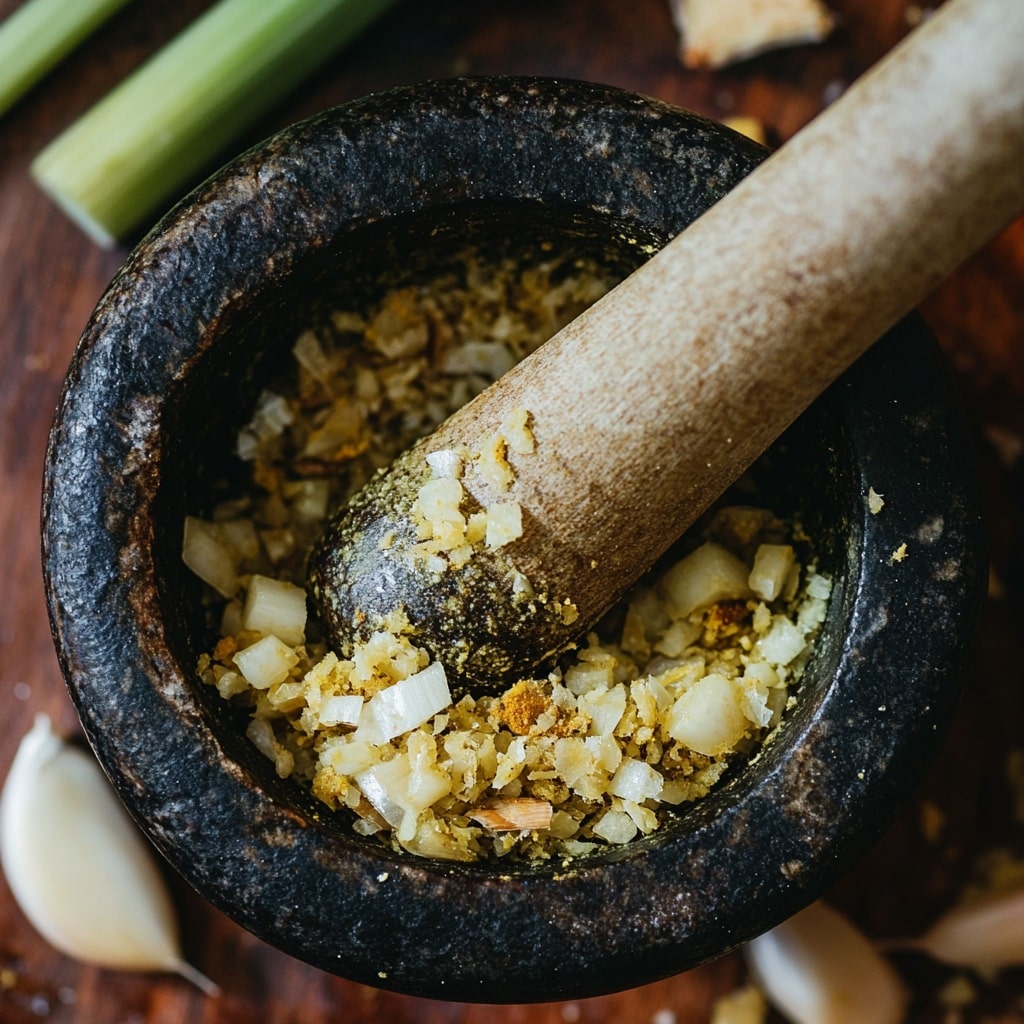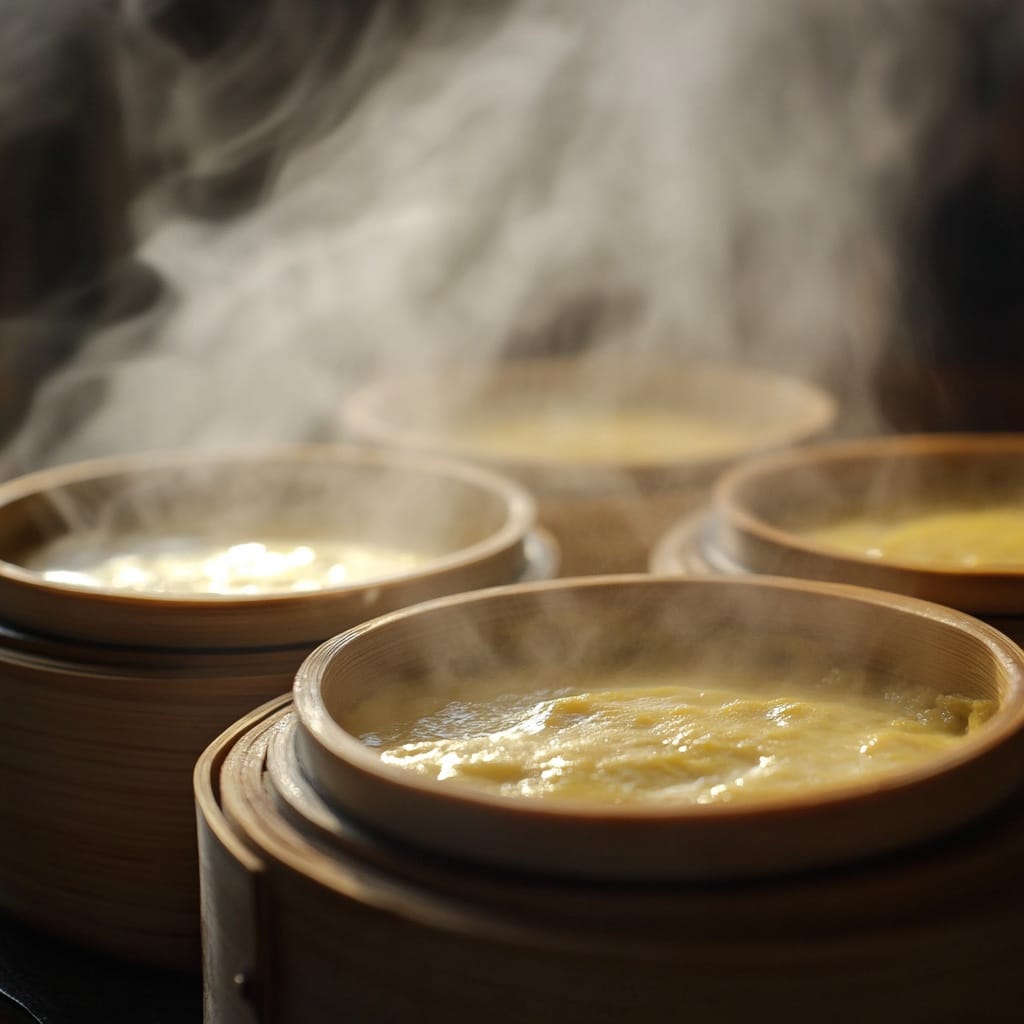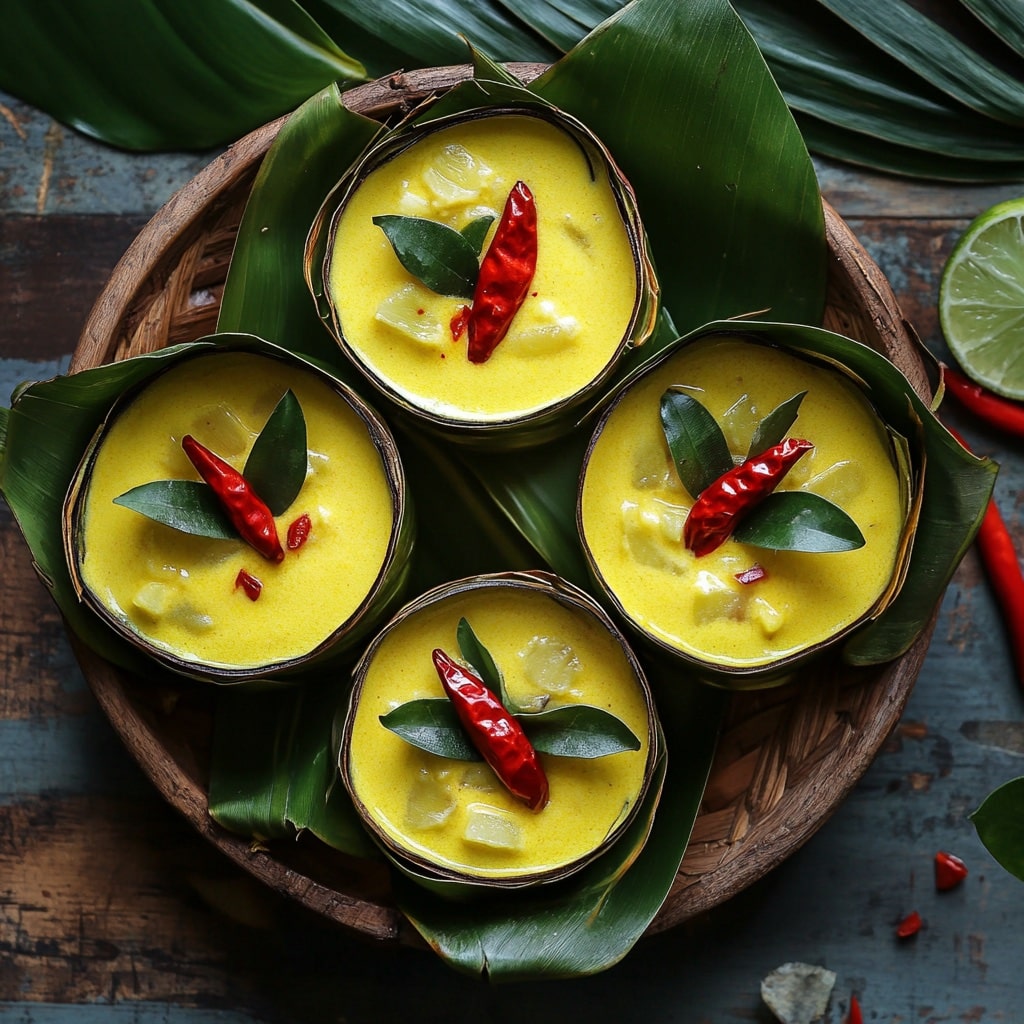Table of Contents
Introduction
If you’re craving something rich, aromatic, and unforgettable, amok curry recipe should be on your radar. This traditional Cambodian dish is a masterpiece of texture and taste. Think silky coconut custard infused with lemongrass, turmeric, and kaffir lime, gently cradling tender chunks of fish. In this article, you’ll learn the full amok curry recipe, from the authentic spice paste to modern serving tips. Whether you’re making it with fish, chicken, or a vegetarian variation, I’ll show you how to bring it together in your own kitchen.
Drawing from Cambodian methods and my hands-on cooking approach at EasyCookedRecipes.com, this guide is simple, practical, and deeply flavorful. We’ll also explore what amok curry recipe tastes like, where it comes from, and how to get it right at home.
Print
Amok Curry Recipe: How to Make Cambodia’s Iconic Fish Curry at Home
- Total Time: 50 mins
- Yield: 4 servings 1x
Description
An authentic Cambodian amok curry recipe made with white fish, coconut milk, and a homemade kroeung paste. Steamed to a creamy custard perfection.
Ingredients
2 stalks lemongrass
1 inch galangal, sliced
3 cloves garlic
2 shallots
1 tsp turmeric
1 red chili, deseeded
3 kaffir lime leaves
1 cup coconut milk
2 eggs
1 tbsp fish sauce
1 tsp palm sugar
300g firm white fish (tilapia or cod)
Instructions
1. Make the kroeung paste by blending lemongrass, galangal, garlic, shallots, turmeric, chili, and lime leaves.
2. Transfer to a bowl and mix with coconut milk, eggs, fish sauce, and sugar.
3. Fold in diced fish and let marinate 10 minutes.
4. Pour mixture into ramekins or banana leaf cups.
5. Steam for 25–30 minutes until softly set.
6. Top with thick coconut cream and garnish with chili or lime.
Notes
Use ramekins if banana leaves are not available.
Tofu can replace fish for a vegetarian version.
Serve hot with jasmine rice.
- Prep Time: 20 mins
- Cook Time: 30 mins
- Category: Dinner
- Method: Steaming
- Cuisine: Cambodian
Nutrition
- Serving Size: 1 bowl
- Calories: 325
- Sugar: 3g
- Sodium: 420mg
- Fat: 22g
- Saturated Fat: 14g
- Unsaturated Fat: 7g
- Trans Fat: 0g
- Carbohydrates: 6g
- Fiber: 2g
- Protein: 25g
- Cholesterol: 120mg
A Taste of My Heritage: Amok Curry Recipe and My Moroccan-American Table
The first time I tasted amok curry recipe, it felt strangely familiar. I was at a Cambodian food stall tucked into a small weekend market in Virginia, and just one bite reminded me of home. The smooth coconut curry, scented with lemongrass and lime leaves, took me back to my mom’s slow-simmered stews from Morocco. Comforting. Rich. Warm.
Growing up with a Moroccan mother and an American father, my food world always balanced between bold spices and familiar comfort. So discovering amok curry recipe felt like a cultural connection. The kind of food you eat slowly and remember later. At EasyCookedRecipes.com, that’s the type of dish I always aim to share.
Why Amok Curry recipe Feels So Comforting
Amok curry recipe is a gentle kind of bold. It doesn’t burn like a Thai curry. It lingers with mellow coconut, earthy turmeric, and subtle heat from fresh chili. Its texture is soft and almost creamy, thanks to eggs whisked into the sauce and the method of steaming.
I made it for the first time using ramekins and parchment instead of banana leaves. It still turned out delicious. The texture was smooth, the sauce fragrant. Since then, I’ve tried it with salmon, tofu, and even shrimp. Every version brings out a different side of the curry. With sticky rice and pickled vegetables, it becomes a complete meal, just like many others in our comfort food collection.
What Is Amok Curry recipe Made Of?
The Traditional Ingredients That Build Flavor
An authentic amok curry recipe starts with fresh, aromatic ingredients that are ground into a paste called kroeung. This paste isn’t just a flavor base; it’s the defining core of the dish. It’s made from a handful of bold elements including lemongrass, galangal, garlic, turmeric, and shallots. Each of these contributes to the dish’s distinct herbal and earthy aroma.
Once the kroeung is prepared, it’s blended with coconut milk, which acts as the rich liquid foundation. Coconut milk provides a silky texture that soaks into the fish or protein used, and balances the warmth of the spices with mild sweetness.
Another key component is the egg. Beaten into the curry mix, it allows the sauce to gently set when cooked. This gives amok its signature consistency, which sits between a custard and a mousse. The dish is often steamed, helping it hold form without drying out.
Finally, shredded kaffir lime leaves are added at the last moment to brighten the flavor with their unique citrus fragrance. These aren’t optional, they lift the entire dish and tie everything together.
Here’s a helpful breakdown of what goes into this classic Cambodian dish:
Amok Curry Recipe Essentials
| Ingredient | What It Brings to the Dish |
| Lemongrass, Galangal, Garlic, Shallots | Forms the spice base with intense aroma |
| Turmeric and Mild Red Chili | Adds warm color and subtle heat |
| Coconut Milk | Smooth and creamy texture with rich flavor |
| Eggs | Helps thicken and bind the curry during steaming |
| Kaffir Lime Leaves | Delivers a fragrant citrus note to balance richness |

Why Steaming and Wrapping Are Part of the Magic
What makes an amok curry recipe stand out even more is how it’s cooked. In Cambodian kitchens, the curry is typically spooned into handcrafted banana leaf cups and gently steamed. This traditional method locks in moisture and infuses the curry with a subtle leaf fragrance.
If banana leaves aren’t available, ramekins or heat-safe bowls work well. In our version on EasyCookedRecipes.com, we’ve tested parchment paper and ceramic dishes to great success.
Coconut milk and steam together transform the curry into something incredibly soft and delicate. It’s a unique method not common in many curries, and it’s part of what makes amok a national treasure.
Amok Curry Recipe Variations Around Cambodia
Classic Cambodian Fish Amok
The most recognized form of the amok curry recipe in Cambodia is made using white fish. Known as amok trei, this version is a cultural staple and commonly served during festivals or family gatherings. What makes it unique is how the fish is combined with a freshly ground spice blend, then gently cooked until the texture becomes rich and custard-like.
The traditional choice of fish includes options like snakehead, goby, or catfish due to their soft texture and ability to soak up the flavors of the curry without disintegrating. These proteins are mixed with coconut milk and eggs, then gently spooned into handcrafted containers made from banana leaves. Once steamed, the curry becomes thick, smooth, and deeply aromatic.
While many Cambodian homes serve this dish with steamed rice, it’s often enhanced with coconut cream and garnished with red chili slices or shredded lime leaves for a final touch of brightness and heat.
For home cooks outside Cambodia, this version works beautifully with common white fish like cod or tilapia. We’ve tested several of these adaptations in our own Asian meals collection and found they maintain the essence of the original.
Adaptations Using Other Ingredients
As more cooks experiment with the amok curry recipe, it’s become clear that the dish is incredibly versatile. While fish remains the traditional choice, there are plenty of exciting variations.
One of the most flavorful is chicken amok, which brings in a heartier bite. Boneless chicken thighs are ideal because they stay juicy during the steaming process and pair well with the creamy coconut base.
Another popular variation is prawn or shrimp amok. This version offers a slightly sweet and briny flavor that balances perfectly with the herbal curry paste. For best results, use raw prawns and clean them thoroughly before adding them to the mixture.
If you’re looking for a meatless meal, vegetarian amok is a delicious option. Tofu works well as a base, especially when combined with tender vegetables like mushrooms, baby corn, or zucchini. These ingredients hold their shape while absorbing the rich flavors of the curry paste and coconut milk.
All these options follow the same fundamental steps: prepare the spice paste, mix it with coconut milk and egg, fold in your chosen protein or vegetable, and steam it until just set. The final result is always deeply fragrant and layered in flavor, no matter the twist you choose.
How to Make Authentic Amok Curry Recipe at Home
An Easy, Step-by-Step Approach for Home Cooks
If this is your first time making an amok curry recipe, you might be surprised at how accessible it really is. While the flavors are deep and layered, the process is friendly even for beginners. The magic happens when the rich coconut mixture transforms into a tender, scoopable curry through gentle steaming.
Here’s how you can recreate this iconic Cambodian dish in your own space:
Step 1: Prepare the spice blend
Chop fresh lemongrass, galangal, garlic, shallots, turmeric, and a mild red chili. You can use a food processor, but if you want to keep it traditional, mash them by hand using a mortar and pestle. The resulting paste is highly aromatic and serves as the base of the dish.

Step 2: Build the coconut mixture
Place the paste into a bowl. Add full-fat coconut milk, whisked eggs, a bit of fish sauce, and a touch of sugar. Mix everything until the texture becomes smooth and unified.
Step 3: Mix in your chosen filling
Choose your protein, whether it’s fish fillet, cleaned shrimp, tofu cubes, or bite-sized chicken pieces, and stir it into the coconut mixture. Set it aside for several minutes to allow the ingredients to meld.
Step 4: Fill your cooking cups
Though banana leaves are customary, ceramic or heat-safe bowls work just as well. Ladle the mixture into each container, filling them about two-thirds full so they have space to expand during steaming.

Step 5: Steam with care
Arrange your cups inside a steamer. Cover securely with a lid and keep the heat on low to medium. Steam for about 25 minutes, until the mixture firms up into a light, set custard without excess liquid.
Step 6: Final touch before serving
Finish with a spoonful of coconut cream, then add thinly sliced chilies or kaffir lime leaves for garnish. Serve alongside jasmine rice or pair it with something from our quick dinner section to complete the meal.
Lisa’s Tips for Home Success
- Use freshly chopped aromatics to capture bold flavor.
- Keep the steaming temperature gentle to maintain the curry’s soft finish.
- Ramekins make a reliable substitute for banana leaves.
- Allow the dish to cool slightly before serving to help it set properly.
Once you get comfortable with the process, this recipe becomes a favorite you’ll return to again and again. It blends comfort with complexity, and every bite carries tradition.
What Fish Is Best for Amok Curry Recipe?
Choosing the Right Texture and Flavor
The heart of a traditional amok curry recipe lies in its smooth, custard-like texture. To achieve this, the type of fish you use is just as important as how you prepare it. You’ll need a fish that holds together while steaming yet still becomes tender enough to blend into the curry base.
White-fleshed, mild-flavored fish are ideal. You want something that won’t overpower the spice blend but will still add body and moisture to the dish. Firmness is also key, soft fish will fall apart, while overly dense ones may resist absorbing the flavors.
Here are some of the best options:
| Fish Type | Why It Works Well |
| Tilapia | Mild flavor, firm texture, widely available |
| Cod | Holds shape well, delicate and clean taste |
| Catfish | Traditional in Cambodia, rich and tender |
| Grouper | Slightly sweet, firm enough for steaming |
| Haddock | Flakes easily without falling apart |
Each of these options works beautifully in the amok curry recipe, whether you’re steaming in banana leaves or using ramekins.
Fresh vs. Frozen: What’s Better?
Fresh fish is always preferred when available, especially for recipes where the flavor of the fish carries through the entire dish. It ensures better texture, less wateriness, and a more natural taste. However, if fresh fish isn’t an option, frozen fillets can be used, just make sure they’re fully thawed and patted dry before cooking.
Avoid pre-marinated or heavily processed fish, as the added sodium and flavorings may conflict with the delicate balance of the kroeung spice paste and coconut cream.
If you’re experimenting or cooking on a budget, tilapia is one of the best affordable choices. It’s dependable and available in most grocery stores, making it a favorite in our quick and affordable meals as well.
Remember, the fish isn’t meant to stand out sharply, it’s meant to blend into the soft curry custard, offering flavor and protein without stealing the show.
What Does Amok Curry Recipe Taste Like?
A Balance of Subtle Heat, Creamy Richness, and Fragrant Depth
Describing the flavor of a true amok curry recipe is like explaining a warm hug in food form. It’s silky, comforting, and unfolds in soft waves of flavor. Each bite carries a gentle complexity that’s both familiar and surprising.
Amok curry Recipe is known for its smooth, mellow taste. It doesn’t blast you with heat. Instead, it gently builds layers of earthy spice and herbaceous aroma. The traditional kroeung base blends ingredients like lemongrass, turmeric, galangal, and chili to create a vibrant but balanced flavor foundation. Hints of lime zest and mild spice are gently wrapped in the lush creaminess of coconut milk.
Eggs are whisked into the mix, giving the curry its signature texture, softly set, rich, and spoonable like a tender custard. When fish is used, it melts into the dish, enhancing the taste without overtaking it.
This isn’t a curry that shocks your palate. It comforts with every bite and leaves a gentle impression of warmth and depth.
What Makes the Taste So Special?
Amok curry’s charm comes from its perfectly layered simplicity. Every ingredient plays a role, but none scream for attention. The end result is a seamless fusion of taste and texture, soft, savory, aromatic, and delicately sweet.
Even newcomers to Cambodian cuisine find this dish easy to love. Its accessible spice level and balanced flavor profile make it a welcoming introduction to the country’s food culture. We feature our favorite variations in the Asian Recipes section where it continues to earn praise from readers looking for something both authentic and easy to make.
If you’re after a dish that satisfies and comforts in equal measure, this is the one to try.
Conclusion
There’s something timeless about a dish like amok curry recipe. It’s not just the creamy coconut base or the delicate blend of spices, it’s the way everything comes together to create something deeply comforting, subtly layered, and surprisingly easy to make at home.
Whether you’re exploring Cambodian cuisine for the first time or looking to recreate a favorite from your travels, this amok curry recipe offers the perfect place to start. With simple ingredients, clear steps, and plenty of room to make it your own, it’s a dish that speaks to tradition and welcomes creativity.
From selecting the right fish to mastering the slow steaming technique, each part of the process adds to a meal that feels special but never complicated. And the best part? You don’t need a professional kitchen to bring the bold, gentle flavors of Cambodia right to your dinner table.
So gather your ingredients, clear some space, and let your kitchen fill with the fragrant steam of lemongrass, turmeric, and coconut. Then sit down, take a bite, and enjoy a recipe that has stood the test of time, one delicious, spoonable moment at a time.
Looking for more simple and flavorful inspiration? Visit our Asian Recipes or try one of our Quick Dinner Ideas to keep the flavor going all week long.
Frequently Asked Questions About Amok Curry Recipe
Where is amok curry from?
Amok curry is a well-known Cambodian dish, celebrated across the country for its cultural and culinary importance. This flavorful curry is traditionally made with fish, coconut milk, and fragrant herbs, gently steamed in banana leaves to lock in moisture and aroma, a true expression of Cambodian tradition.
What is amok sauce?
The sauce in an amok curry recipe is a rich, coconut-infused blend that carries the dish. It combines freshly prepared kroeung spice paste with coconut milk, beaten eggs, and savory elements like fish sauce and palm sugar. As it steams, the mixture thickens into a smooth custard that coats the fish and ties everything together.
Is amok Khmer or Thai?
Amok is deeply rooted in Khmer (Cambodian) cuisine. While some may confuse it with Thai-style curries due to shared ingredients like coconut milk, amok sets itself apart through its unique preparation, gently steamed and custard-like, with soft spices and subtle layering rather than bold heat.
What kind of fish is amok?
The traditional amok curry recipe often includes freshwater fish native to Cambodia such as catfish, goby, or snakehead. These types of fish remain firm through steaming while soaking up the rich, spiced coconut blend. In Western kitchens, tilapia, cod, or even salmon serve as excellent substitutes.
Which curry is best for fish?
Amok curry is widely recognized as a perfect match for fish. Its creamy, spice-balanced profile enhances the delicate flavor of fish without masking it. The gentle steaming technique also keeps the texture of the fish moist and tender, which is why many cooks choose this method when working with seafood.
What does amok taste like?
Amok curry is creamy, gently spiced, and filled with herbaceous warmth. You’ll taste notes of lemongrass, turmeric, galangal, and coconut milk, with a smooth, slightly sweet finish. Unlike fiery curries, amok offers a mellow experience that comforts and satisfies with every bite.

